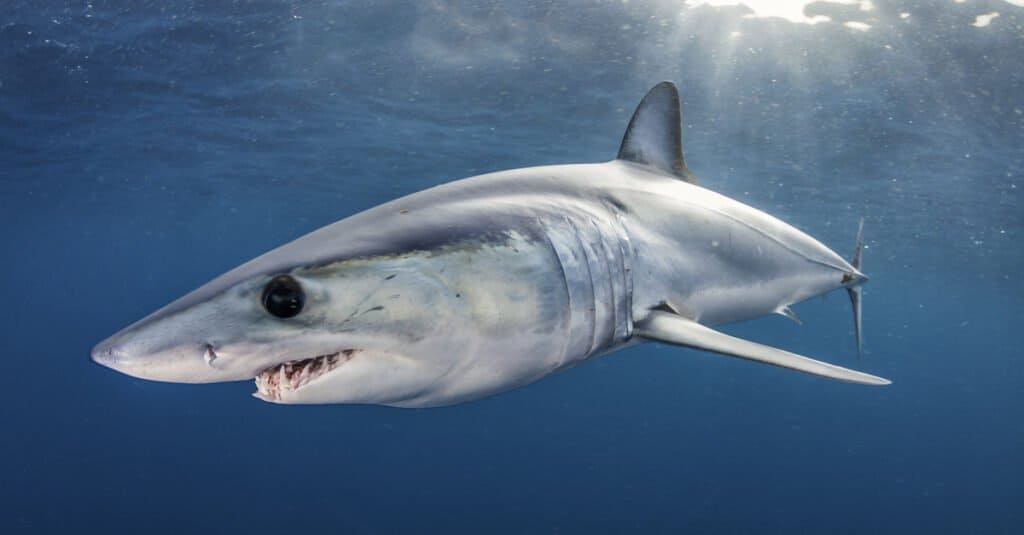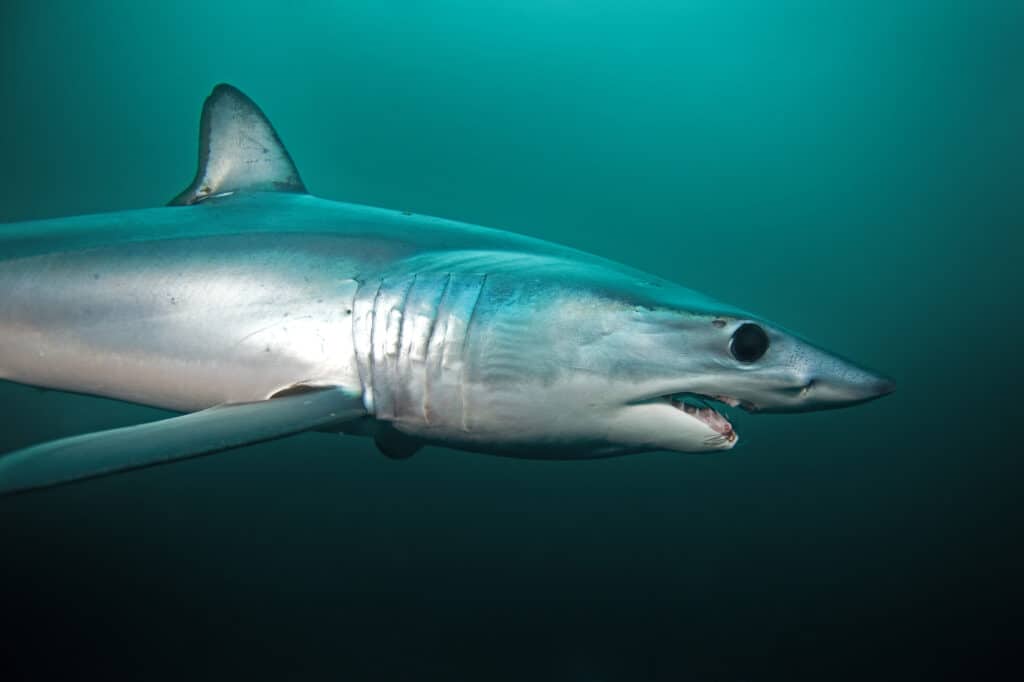The mako shark, with two distinct species, is one of the largest types of shark in the open sea. They also have long, athletic bodies that allow them to hunt and migrate the waters efficiently. But where do mako sharks live? What should you know about their location?
This post provides comprehensive answers to the location of both mako shark species. You also get to learn about features that make them adaptive to this environment.
Where Do Mako Sharks Live?

Mako sharks have a wide geographical range which includes tropical and temperate waters.
©wildestanimal/Shutterstock.com
One interesting fact about mako sharks is their wide geographical range. They can live in all types and categories of large water bodies. Mako sharks are found in tropical waters, temperate waters, and subtropics. Like many other sharks, they prefer warm waters.
The two distinct species of mako sharks both have varying qualities and features that distinguish them from each other. Their specific location and migratory habits are among those varying qualities. The species are the shortfin mako shark and the longfin mako shark.
1. The Shortfin Mako Shark (Isurus oxyrinchus): This species of mako shark is especially popular for living in the deep parts of the sea. Shortfin mako sharks can spend considerable time deep in the water. This depth can be about 400ft in the oceans.
In terms of location, there are two groups of shortfin mako sharks. One group is seen in the Atlantic. This group roams the Atlantic areas of the Gulf of Mexico to the northern parts of America. Popular regions in North America where you find mako sharks include Florida. The Texas part of the Caribbean Sea also has several mako sharks swimming and dwelling in them.
The second group is seen in the Pacific waters. When traveling the waters of the Columbia River, you can find this shark species in Chile. These are the Eastern Pacific dwellers. California also has a large number of this species off the west coast and remains a reliable place to find shortfin mako sharks.
2. The Longfin Mako Shark (Isurus paucus): This species mainly prefers the tropics, but they are quite comfortable in temperate and tropical waters. Like the shortfin mako shark, they have a wide range of locations.
The Atlantic group lives in the Caribbean Sea and from northern Cuba to Florida. This is the group that lives in the western Atlantic. The eastern coast of the same ocean has most of this group dwelling in it. You can also find some in the seas bounding West Africa.
Note that the spottings are often not precisely accurate because people often mistake longfin for shortfin mako sharks.
Mako Shark Lifespan: How Long Do They Live?

Mako sharks have an average lifespan of 25 years.
©Xavier ELIAS Photography/Shutterstock.com
Mako sharks have an average life span of about 28 years. The shortfin species live longer, about 30 to 35 years in the seas. On the other hand, the longfin has an average span of 25-29 years. Both species have a lifespan that falls within the broad range of the shark groups.
Are Mako Sharks Endangered?

Mako sharks are endangered.
©Martin Prochazkacz/Shutterstock.com
Mako sharks are actually on a population decline despite all their evasiveness and speed. Both species are in the “endangered” category. What is alarming is the rate of this decline. A couple of years ago, mako sharks were in the “near threatened” category. But unfortunately, the numbers of these sharks have decreased significantly to the extent that they are feared to face extinction soon.
Great white sharks are the natural predators of shortfin mako sharks, while orcas naturally prey on longfin mako sharks. However, the greatest threat they face is overfishing by humans. They are fished in different places mainly for commercial purposes. Because they are considered the best of all sharks to eat, it is not surprising how they have been heavily fished to the point they currently are.
In the US, it has become a regulation to return any mako shark caught during fishing to the sea. This is to preserve the species.
Mako Sharks Adaptations
Both species of mako sharks adapt efficiently to their environment using various adaptation skills. The two species are fast swimmers, which explains their constant migratory habits. They can swim up to 32 mph and are very good deep sea dwellers. Besides these standard features, each species has distinct characteristics that set them apart.
Shortfin mako sharks have a thermoregulation feature that keeps essential organs warm irrespective of external conditions. The vital organs stay active, and the animal remains fast when hunting for prey.
They also have a color combination that helps camouflage them in the sea. Their back is a dark shade that blends well with the background of the sea. The fish’s underside is lighter, and it looks like rays of light coming from the surface. These camouflage attributes make it easier for the sharks to stay hidden from prey and predators.
Perhaps the most adaptive feature of the longfin mako shark is elusiveness. So elusive that scientists haven’t been able to do much research into their adaptation skills. However, they have slender bodies that allow them to maneuver swiftly from predators in the sea.
Up Next:
Reef Shark Location: Where Do Reef Sharks Live?
Lemon Shark Location: Where Do Lemon Sharks Live?
Basking Shark Location: Where Do Basking Sharks Live?
The photo featured at the top of this post is © wildestanimal/Shutterstock.com
Thank you for reading! Have some feedback for us? Contact the AZ Animals editorial team.






